Understanding Flight Zone and Point of Balance for Low Stress Handling of Cattle, Sheep, and Pigs
by Temple Grandin
Dept. of Animal Science
Colorado State University
(Updated March 2022)
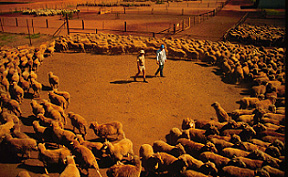 |
| This picture illustrates the flight zone of a large flock of sheep, herds of cattle behave much the same way. Notice that the sheep are circling around the handlers while maintaining a safe distance and keeping the people in sight. Note that the sheep tend to move in the opposite direction of handler movement. Walking in the opposite direction of the direction of desired movement can be used to move groups of animals. Walking in the opposite direction tends to speed up movement and walking in the same direction tends to slow down movements. These principles work with all herding animals. When animals are completely tame they will have no flight zone. Leading is usually the most effective way to move very tame animals. Handlers on farms and ranches can reduce the size of the flight zone by spending time walking through the herd or flock. |
The point of balance is usually at the animal's shoulder and it is determined by the animal's wide angle vision. All species of livestock will move forward if the handler stands behind the point of balance. They will back up if the handler stands in front of the point of balance. Many handlers make the mistake of standing in front of the point of balance while attempting to make an animal move forward in a chute (race). Groups of cattle or pigs in a chute (race) will often move forward without prodding when the handler walks past the point of balance in the opposite direction of each animal in the chute (race). It is not necessary to prod every animal. If the animals are moving through the chute (race) by themselves, leave them alone.
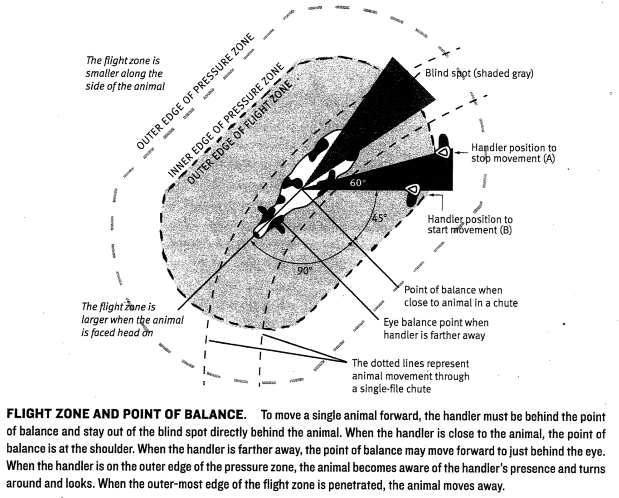 |
| This diagram illustrates the general flight zone of an animal. The actual flight zone of an individual animal will vary depending on how "tame" the animal is. An animal's flight zone will vary depending on how calm it is. The flight zone gets bigger when an animal becomes excited. The flight zone is also bigger when you approach "head on". Calm cattle are easier to move. If cattle become excited, it takes 20 to 30 minutes for them to calm back down. People should be quiet when moving animals. Yelling and loud noise is very stressful. High pitched noises are especially stressful. |
The two curved lines on the diagram represent a curved single file race. The flight zone diagram is especially useful for teaching people how to move cattle through single file races and other confined spaces such as crowd pens. When cattle are handled in a single file race, the point of balance will be at the shoulder. On pastures and large pens, the point of balance may move forward and be slightly behind the eye. The behavior of groups of cattle in pasture is different because they are not confined in a single file race or small pen. The simple flight zone diagram may not work for groups in pasture or large pens because the animals are free to move and are not confined in a race (chute) or small pen. When moving groups of cattle in open spaces, refer to other diagrams on www.grandin.com.
Handlers who understand the concepts of flight zone and point of balance will be able to move animals more easily. The flight zone is the animal's personal space, and the size of the flight zone is determined by the wildness or tameness of the animal. Completely tame animals have no flight zone and people can touch them. Tame animals should be led instead of being driven. Calm leading of groups of cattle is an excellent low stress way to move cattle on pastures. An animal that is not completely tame will begin to move away when the handler penetrates the edge of the flight zone. If all the animals are facing the handler, the handler is outside the flight zone. There principles will work on ranches, stockyards, lairages, feedlots, and many other places.
| When the handler is outside the flight zone but had entered the zone of awareness (pressure zone) the animals will turn and face the handler, and maintain a safe distance. When animals become accustomed to a calm handler and learn to trust the handler they will have less of a tendency to look at the handler. They will walk away straight without turning. The animals have learned that the calm handler will back up and remove pressure from the flight zone when they go where the handler wants them to go. |
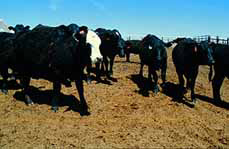 |
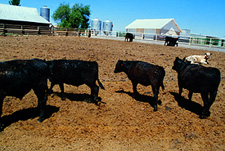 |
When the handler enters the flight zone the animals will turn away. The approaching handler is outside the flight zone of the light colored animal that is still laying down. However, the handler has entered the zone of awareness of the light colored animal because it is looking at the handler. |
| Handler movement pattern to keep cattle moving into the squeeze chute in a curved chute system. |
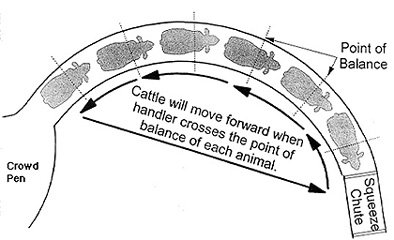 |
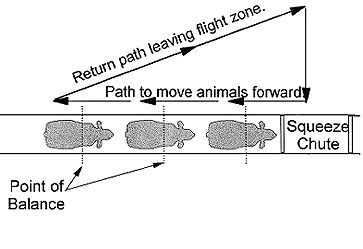 |
Handler movement pattern to keep cattle moving into a squeeze chute or restrainer. The handler steps forward into the flight zone and then walks quickly in the opposite direction of desired movement to make an animal move forward. This movement may also be called reverse flow or reverse parallel (Chris Schachtschneider, 2019). |
Cattle and other ruminants have a tendency to move in the opposite direction when a handler walks deep in their flight zone. The principle of
these two diagrams is that the handler walks inside the flight zone in the opposite direction of desired movement. When the handler returns,
he or she walks outside the flight zone in the same direction.
When an animal is being held in the squeeze chute the handler should stand outside the flight zone. To move the next animal into the squeeze chute, the handler enters the flight zone and the animal will move forward after the handler crosses the point of balance at the shoulder. If an animal rears up in a single file chute, the hanlder should back away from it. Never hit the animal. It is rearing because it is attempting to get away from the person who is deep in its flight zone.
To move only one animal, the handler should stop walking when the point of balance of the animal is crossed.
Keeping Cattle Calm in the Single File Race
People handling cattle in a single file chute (race) must learn to stay back and not continuously stand inside the flight zone when animals are waiting in line. A common cause of cattle rearing or becoming restless while waiting in line in a race is a person who continuously stands inside their flight zone. The animals will usually calm down and stand quietly when the person backs up and removes themselves from the flight zone. The flight zone diagram is useful for teaching this concept. It is especially important when a chute (race) has open sides for people to always stand outside the edge of the flight zone. When a single animal or a group of cattle need to be moved, the handler enters the flight zone to move the animals. After the animals have been moved forward in the race, the handler should immediately backup and retreat from inside the flight zone.
Working Crowd Pens and Tubs
The most common mistake is putting too many pigs or cattle in the crowd pen or tub. Fill the crowd pen half full so animals have room to move. Good handling will require more walking to move small groups of animals into the crowd pen. Use the crowd pen or tub as a "passing through" pen. If animals wait in the crowd pen they are more likely to turn around. The next small bunch of animals should be brought into the crowd pen when the single file race is almost empty. This enables you to use following behavior and the animals will immediately pass through the crowd pen and enter the single file. In round tubs, NEVER attempt to push animals with the crowd gate.
There is a species difference between cattle and pigs versus sheep. Cattle and pigs should be moved through the crowd pen in small, separate bunches. Sheep have such intense following behavior that they can be moved in a more continuous flow. If animals fail to move through a crowd pen easily, try positioning the handler on the opposite side. In a round tub, positioning a handler with a flag outside the pen at the crowd gate pivot point often works really well. The cattle will circle around a person standing at the gate pivot and enter the single file race.
Working Groups on Pasture
When cattle are being handled in confined areas such as races and chutes the point of balance will usually be at the shoulder as shown in the diagrams. When a group of cattle are handled in an open pen the location of the point of balance may be more variable. Ron Gill, a cattle handling specialist, states that the point of balance may not be at the shoulder. He conducts many cattle handling demonstrations where cattle are handled in large open pens. Often a cow will move forward when the handler moves just past her eye. The point of balance on any one particular animal in a large pen or field may vary depending on how it is moving with the group. There are many situations and it is impossible to diagram all the possible anlges for moving groups of cattle on pasture. The main purpose of hte diagrams is to illustrate the concept that both individual animals and a gorup of animlasl has at a point of balance.
Basic Principle
Moving inside the collective flight zone in the opposite direction of the desired movement will spread moement of the entire herd up. Moving outside the collective flight zone in the SAME direction will slow the herd down.
| When moving livestock from a large open area, understanding flight zone behavior and utilizing a few basic principles, moving animals in a calm and orderly fashion at a walk becomes very easy. To keep the animals moving in an orderly manner the handler alternates between penetrating the collective flight zone and withdrawing from the collective flight zone. Alternating pressure on the flight zone is more effective than continuous pressure. Continuous pressure on the flight zone may make the herd run. The handler should back out of the flight zone when the herd is moving in the right direction. This rewards the herd for doing what you want. When the herd slows down or stops, pressure should be applied again. When the handler moves in the zig-zag pattern he/she penetrates the flight zone when walking in the opposite direction of desired movement and retreats from the flight zone when walking in the same direction of desired movement.
|
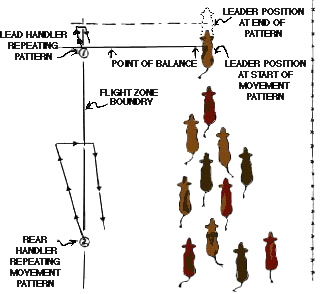 |
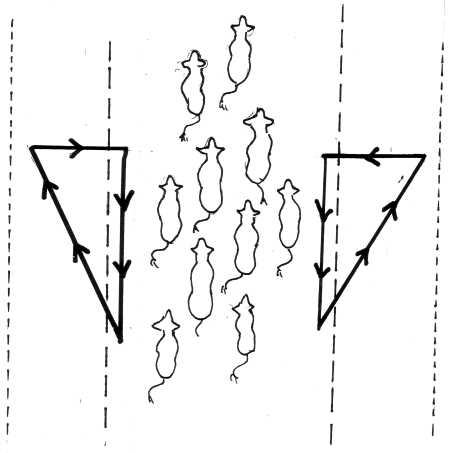 |
This diagram shows the movement pattern when two people are moving a group of cattle. To keep the group moving, the triangle pattern is repeated multiple times. The dotted line with long dashes represents the outer edge of the collective flight zone. The dotted line with small dashes represents the outer edges of the animal's zone of awareness (pressure zone). When the pressure zone is entered, the animals become aware of the handler's presence. The handler is inside the outer edge of the collective flight zone when he walks in the opposite direction of desired movement to speed the herd up and move them forward. The handler is outside the collective flight, but still inside the pressure zone when he walks in the same direction of desired movement. This double triangle pattern diagram is adopted from the work of Guy Glossom, Mesquite, Texas. He warns that it is essential to keep the angles on the triangle sharp. Never allow the triangles to turn into circles. |
Move in straight lines and do not circle around the animals. Do not chase a lone animal or a few stragglers. The motion of the herd will attract them back. A group of animals will have point of balance for the entire group. A good stock person can move the herd by working the group point of balance. The handler should avoid the blind spot behind the animal's rear. Deep penetration of the flight zone should be avoided. Animals become upset when a person is inside their personal space and they are unable to move away. If cattle turn back and run past the handler while they are being driven down a drive alley in the stockyard, overly deep penetration of the flight zone is a likely cause. The animals turn back in an attempt to get away from the handler. If the animals start to turn back, the handler should back up and increase the distance between himself and the animals. Backing up must be done at the first indication of a turn back. If a group of animals balk at a smell or a shadow up ahead, be patient and wait for the leader to cross the shadow. The rest of the animals will follow. If cattle rear up in the single file chute (race), back away from them. Do not touch them or hit them. They are rearing in an attempt to increase the distance between themselves and the handler. They will usually settle down if you leave them alone.
 |
A group of cattle moving as a herd maintains eye contact with each other, that way the entire herd can move as a coordinated whole. The next animal behind the leader is positioned just behind the leader's point of balance.
* This is the same position that a person would stand in to move the animals. |
| Using the principles of flight zone behaviour, a handler is able to move cattle into a pen in a calm and orderly way. Using the positions shown on this diagram will enable the handler to control the flow of cattle through the gate. Cattle movement can be slowed or speeded up by moving forward or backward.
|
 |
 |
Diagram for moving cattle quietly out of a gate. The handler moves in a small triangle as shown on the diagram. Sometimes the handler barely has to move after the flow is started. A good way to visualize the movement is that after the flow through the gate is started, the cattle moved around the handler on the edge of a bubble that is like a "force field" around the handler. The cattle position themselves in relation to the handler so they maintain a flight zone between themselves and the handler.
|
2018 Update
Cattle Sorting Tips
"Cattle want to see you" according to Ron Gill, Texas A&M University. They will turn and look at you when you are just outside of their flight zone. There are many different names for this zone, such as pressure zone, zone of awareness, or zone of influence. Cattle handling specialist Curt Pate explains that groups of cattle can be easily sorted through a gate by using a combination of "driving pressure" when the flight zone is entered and "drawing pressure" when the handler is just outside the boundary of the flight zone. The cattle will want to watch and walk towards the handler. A skilled person can sort cattle by carefully alternating between "driving pressure" and "drawing pressure" to sort individual cattle from the others.
Handling Groups: Driving Versus Leading
There have been many discussions on whether cattle should be driven or led. In feedlots, cattle handling specialists Ken Sullivan in Australia and Tom Noffsinger in Nebraska are teaching feedyard employees to lead cattle instead of drive them. Sullivan teachers people to lead new arrivals to show them where the feed and water is located. Many ranchers who often switch pastures will also lead their cattle. Leading works well when people take the time to develop trust with their cattle. Good stockmanship required patience and time to learn. However, it is recommended to teach cattle how to drive in and out of pens. This will prevent them from becoming stressed when they are taken to an auction, feedlot, or meat plant. The minimum driving skills they need to learn are moving down a wide alley and entering and exiting pens. This will train them how to move when they are taken to a new place where driving is used.
2019 Update
Basic Principles from Chris Schachtschneider, Oregon State University
- Cattle learn from the release of pressure on the flight zone. Chris was able to load bulls into stock trailers that had no handling facility. Every time a bull looked at the trailer or stepped towards it he released pressure on it. He warns people to avoid the urge to apply more pressure when an animal gets close to a gate or other desired destination.
- Is your Handling Low Stress? Handling is high stress if animals run. All cattle movements should be at a walk or slow trot. You have achieved low stress handling if the cattle start grazing or eating shortly after handling. Cattle are stress if grazing is delayed or calves are slow to mother up. You have achieved low stress handling if calves quickly find their mothers.
2022 Update
Bob Kinford is training ranchers in the art of Instinctual Migratory Grazing. This method enables ranchers to place cattle in areas where they do not normally graze. Instead of moving cattle from the rear, they are moved from the front of the herd. It takes advantage of the natural behavior of cattle to follow the leader. Kinford's website contains a whole series of videos on a section title Migratory Grazing, Rebooting the Herd Instinct. When it is done correctly, the herd learns to follow riders to a new pasture. Heather Smith Thomas wrote an article in The Stockan Grassfarmers about Riki and Justin Keremer's ranch in Lusk, Wyoming. Kinford taught them how to move the cattle and get them to stay in one area or a bunch and more evenly mow the grass. They learned how to lead thin herds through narrow gates and throught other pastures to the place where they wanted them to stay.
Video links to YouTube
Cattle handling in crowd pens showing a handler using a flag
Handling cattle quietly in pens. Video Shows cattle calmly flowing past the handler and moving out through a gate.
Temple Grandin Yard Demo at Beef Works shows calm movement through a single file race.
Link to Temple Grandin's video collection on Livestock Handling
Link to Bob Kinford's Stockmanship and Instinctual Migrating Grazing website
References
Grandin, T., 2017. Temple Grandin's guide to working with farm animals. Storey Publishing. North Adams, MA.
Granin, T. 2015. Improving Animal Welfare: A Practical Approach. CAB International, Wallingford "A Practiclal Approach. CAB International. Wallingford, Oxen, United Kingdom.
Grandin, T. (Editor) 2019 (5th Edition). Livestock Handling and Transport. CAB International,Wallingford Oxon, United Kingdom.
Grandin, T. (1989). Behavioral Principles of Livestock Handling Professional Animal Scientist. December 1989. Pages 1-11.
Grandin, T. and Deesing, M. 2014. Genetics and the Behavior of Domestic Animals, 2nd Edition. Academic Press (Elsevier).
Grandin, T. and Deesing, M. 2008. Humane Livestock Handling. Storey Publishing, North Adams, Massachusettes.
Kilgour R. and Dalton D.C. 1984. Livestock Behaviour, A Practical Guide. Collins Technical Books. Glasgow United Kingdom.
 Click here to return to the Homepage for more information on animal behavior, welfare, and care.
Click here to return to the Homepage for more information on animal behavior, welfare, and care.











